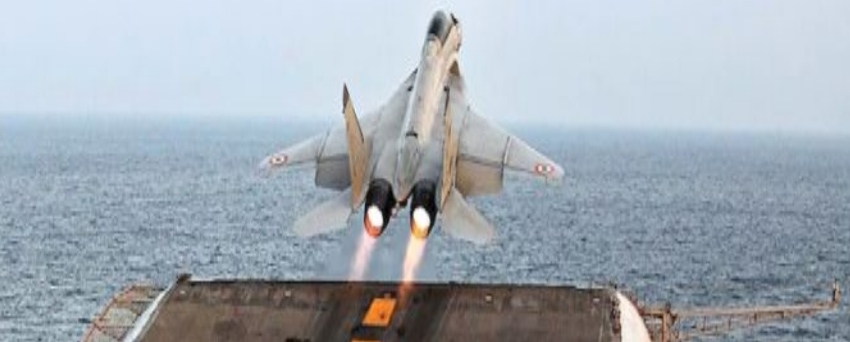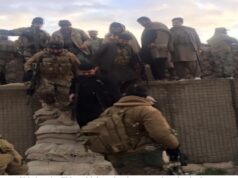Third Aircraft Carrier By 2030 Most Essential For India
By
Rear Admiral Sudhir Pillai (Retd)

A MiG-29K takes off from INS Vikramaditya
India needs both. Short-term fiscal constrictions must be weighed against long-term strategic visions
India finds itself in a strange situation. On one hand, the Chief of Defence Staff says the Indian Navy does not need aircraft carriers, while the Chief of Naval Staff has been emphasising their continued utility. This needs to be looked at from a deeper strategic perspective lest we straitjacket military readiness at a time when the demands on the Indian Navy continue to rise.
With reference to the Chinese Navy’s rising competence, Sir Julian Corbett’s Some Principles of Maritime Strategy is informative. ‘The object of naval warfare must always be directly or indirectly either to secure command of the sea or to prevent the enemy from securing it.’ The shifting balance of power, aided by China’s economic rise and the emergence of a powerful Chinese Navy and associated land-based sea-denial forces, has forced the US and, in recent days, Britain, Canada and the EU, to pivot to the Indo-Pacific. Initiatives such as the QUAD, QUAD Plus and the Indo-Pacific Command are all aimed to protect the international maritime system.
The challenge emanating from the aggressiveness of China in the South and the East China Sea requires navies to think through sea-control concepts afresh and search for innovative counters to anti-access and area-denial strategies. While it is beyond the scope of this article to look at doctrinal roles in detail, navies examine such aspects in great detail, and such assessments can be revealing.
In areas where shore-based air support is viable, India will need to evolve joint operational-level schemes between the Indian Navy and the Indian Air Force when it creates air defence or maritime theatre commands. Aircraft carriers remain relevant beyond such areas and can at times be the only go-to option. An aircraft carrier group can autonomously seek localised sea control when convoying critical cargo or mount sea-denial challenges using integral anti-submarine helicopters. Assessments also suggest that the development of unmanned aircraft could revitalise the role of aircraft carriers as the eyes of the fleet. Navies look to operate various Unmanned Aerial Vehicles (UAVs) from aircraft carriers to conduct C4ISR (Command, Control, Communications, Computers, Intelligence, Surveillance and Reconnaissance) missions or as airborne relay nodes for networks that may be vulnerable to satellite destruction or electronic jamming. Thus, plans for the second indigenously-built aircraft carrier, INS Vishal, would serve India well. Such projects would also help develop shipbuilding and industrial competencies.
A popular perception is that submarines can provide sea control given their relative stealth and invulnerability. However, it must be considered that submarines are essentially a warfighting-only platform, while ships like aircraft carriers are valuable platforms for roles across the spectrum of conflict. A Carrier Battle Group (CBG) is a valuable adjunct as a submarine-support vessel. CBGs can not only provide C4ISR services but also disrupt enemy air and surface anti-submarine warfare (ASW) efforts, and even conduct ASW operations themselves.
In 2015, the Indian Navy released a strategy document, ‘Ensuring Secure Seas: Indian Maritime Security Strategy’ (IMMS-2015), as guidance for the Indian Navy’s growth, development and deployment in the coming years. The document outlined the need to develop future naval fleets to include three CBGs, each centred on an aircraft carrier with multi-mission escorts and support ships. These plans focus on ‘future challenges’ with planned force levels of 200 warships and a 500-aircraft fleet by 2027. Whilst these numbers represent a bean- counting exercise for hulls and airframes, IMMS- 2015 flags the need for how these platforms will need to adapt ‘leapfrogging technologies’ capable
of combating emergent threats. These hulls and airframes will need to evolve through their lifecycle through innovative mid-life upgrades, functional enhancements, system expansions, retrofits and overhauls. As technologies mature, one may well see some of these upgrades leading to artificial intelligence replacing human operators!
No plan on paper can achieve much without budgetary support. India’s economic growth has, however, stalled since 2017. The naval budget has been scaled back from 18 per cent of the total defence budget in 2012-13 to 13.66 per cent in 2018-19. The modernisation budget of the Navy has been scaled back from 8.7 per cent in 2015-16
to 4.9 per cent in 2018-19. The operational implication of these cuts needs close consideration. Navies the world over evolve by striking a balance between doctrinal roles and operational imperatives vis-a-vis fiscal reality. What is essential is to balance the necessities of maritime imperatives against continental strategies by apportioning budgetary support.
While the deadlock on military de-escalation in Ladakh continues, Lt Gen. Prakash Menon, a former military advisor to the National Security Council Secretariat, cautions us to view the military moves in Ladakh from the broader perspective of China-US geopolitical rivalry. He opines that China views India as an impediment to its ambitions, given India’s maritime geography and deepening concert with other naval powers. If such assessments have a basis, India would do well not to stall investments towards the build-up of the Indian Navy’s capabilities and capacities at sea. Thus, budgetary support can be crucial to ensure that the evolving ‘string of pearls’ does not become a noose.
Air Marshal M Matheswaran, in a study under- taken for the ANU National Security College/ the Australian Department of Defence, opines: ‘A third aircraft carrier is a vital necessity for the Indian Navy, given the current tensions with China. But with the Indian government delaying its decision, the chances of a decision favourable to the navy may be receding.’ Significant Chinese naval development and the emergence of that force with formidable operational structures permitted by new generations of weapons and sensors require the Indian Navy to be structured and built for evolving missions and a vision extending far beyond Indian shores.
Studies of Japanese and Chinese military progress reveal the development and nurturing of innovative funding models. India needs to embrace private and public-private enterprise as envisioned in the Strategic Procurement model. Else the Indian Navy’s capability, built at considerable time and effort, could erode. We must not turn the clock back.




